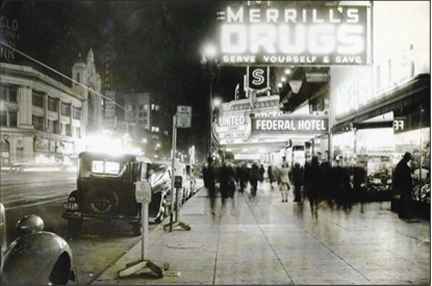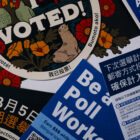Warfield Building owner David Addington described marching over to the Elections Department with 12,000 signatures on his Mid-Market Special Sign District ballot initiative, accompanied by 20 children and teachers from the Rescue Mission’s City Academy summer program.
He said he spent several years, working to bring general advertising back on Market Street from Fifth to Seventh streets, in hopes of returning the central city stretch to its former glory days as a theater district. The children took part of the July 1 march because, if the initiative passes in November, Tenderloin and South of Market youth groups will receive up to 40 percent of sign advertising revenue for arts and education programs.
Addington’s enthusiasm for the special district hasn’t dimmed, but a sense of reality has crept in as opposition to the initiative, Proposition D, mounts. Only four years ago, a San Francisco Business Times storychronicled the Mid-Market PAC’s 10-year effort to transform it from Fifth to 10th streets.
The Redevelopment Agency approved the PAC’s plan and the Planning Commission said it conformed to the city’s General Plan, but it met resistance from organized neighborhoods, was panned by Supervisor Chris Daly for not providing enough affordable housing, and died in committee. Addington and Carolyn Diamond, Market Street Association executive director, were prime movers in the PAC. She joined as Prop. D co-author in June.
“I do think this is a controversial issue,” Diamond said, “but that’s what I really like about it. It will bring buzz to the area. It’s a big, unusual idea. Maybe it will be what finally brings economic development to mid-Market.”
The proposed district includes 52 buildings. Each building could sport new signs — though some might be as small as 2-by-5-feet — bringing much-needed revenue to an area where half the ground-floor retail is shuttered and, Addington said, more than 50 percent of the office space is unoccupied.
Prop. D’s biggest hurdle is that it exempts the district from two hard-won zoning laws: one, on the books since 1970, bans all general advertising on Market Street from the Embarcadero to Octavia Boulevard. The other, Proposition G, approved in 2002 by 78 percent of the voters, prohibits new general advertising citywide.
“General advertising” refers to goods or services not sold where the ads are displayed — such as a Verizon ad on the Grant Building. Business service advertising, such as an iPod ad on an Apple store, isn’t regulated by the two billboard laws or Prop. D. Marquees and other historical signs also are outside the purview of Prop. D and are encouraged by an ordinance passed last year.
As the election nears, Addington, Diamond and other supporters have been making the rounds looking for ballot endorsements and community support. They’ve been to the Alliance for a Better District 6, Tenderloin CBD, Tenderloin Economic Development, SPUR, Yerba Buena Alliance, Convention and Visitors Bureau, Golden Gate Restaurant Association, Union Square Association, San Francisco Architectural Heritage and many more.
“Mostly, people have been positive,” Diamond said.
By late August, Addington said, “I know this is going to be an uphill battle.”
What the ordinance says
Prop. D calls the proposed district “a distinct segment of downtown … a locale for entertainment and arts institutions.” The hope is that signage will give a shot of energy to what’s there now. Theaters include the Golden Gate, Warfield, Market Street Cinema, Crazy Horse, St. Francis and the Regal (both recently closed). The Guild at 1069 Market and the Centre at 1071 Market, both built in the 1920s, closed in 1987 after decades of showing adult films. The number of arts venues is few, just The Luggage Store and Red Ink Studios.
Prop. G’s citywide ban on general advertising may be appropriate for other locales, but Prop. D calls it “an unfair burden” on mid-Market owners who could use the revenue to “maintain or establish entertainment and arts venues in their building, creating a unified and distinctive visual environment.”
The initiative limits signs to 500 square feet. Roof signs, wind signs, video and digital signs, rotating signs, wall signs, signs with moving parts and illuminated signs are allowed, with conditions on height, position, movement and illumination. All must conform with the sign district’s stated purposes: to make the area attractive as a tourist destination; reinvigorate mid-Market; retain and not compromise the area’s historic architectural character; and use portions of ad revenue to fund neighborhood youth and arts activities.
The Central Market Community Benefit District, formed in 2006, with boundaries extending from Fifth to Ninth along Market Street plus parts of Stevenson, Jessie and Mission streets, will be the sign district’s administrator and fiscal sponsor. When a building owner wants to sell sign space, the first stop for decisions about its conformity and contract review will be a new CBD subcommittee.
Members won’t be named unless the initiative passes. If it does, Addington said, members will include experts in architectural heritage, representatives from the Planning Department and the Arts Commission, members from the Central Market and Tenderloin CBDs, residents, small business owners and other neighborhood stakeholders. After the subcommittee reviews a proposed sign, it will require permit approval from the Department of Building Inspection.
Property owners don’t get to keep all the revenue from green-lighted billboards. If the building’s ground floor is used primarily for arts activities, as defined by the planning code, owners must contribute 20 percent of the revenue from each sign to a special district fund; if the space isn’t used for arts, the property owners pay 40 percent.
Programs to benefit youth
Under the initiative, the CBD will collect the revenue and decide how to apportion it. The initiative lists as priorities: arts education programs for youth (the CBD may solicit proposals from neighborhood groups); a Hallidie Plaza booth to sell tickets to arts, entertainment and cultural activities in the district; and CBD expenses for administering the district. The CBD can use leftover revenues to promote arts in the area.
“Ad revenue is based on ‘impressions’ — how many people pass a sign on the road or on foot,” Addington said. “The number of impressions in this area is questionable now, but if Prop. D passes and we can offer exclusives to advertisers and show the area is a cool and interesting destination with real-time excitement, advertisers might be able to see beyond the idea of impressions.”
He offered some examples of what ads go for: A sign currently up on the Mission Street side of 995 Market brings its property owner $18,000 a month. One of comparable size in Union Square might generate $75,000 a month. A glittery, spectacular billboard in Times Square could pull down $300,000 a month.
For and against
Addington said he’s talked with the owners of all 52 buildings in the proposed district.
“None have reservations about the initiative except Laurie Lazer and Darryl Smith at the Luggage Store (1007 Market) — they’re artists and they have aesthetic concerns.”
Smith told The Central City Extra that he admires Addington’s enthusiasm, but worries whether there will be a lot of schlock on the two blocks.
“I won’t actively fight it,” he said, “but I won’t support it either. I’m wary of the ‘artistic presence’ of electronic billboards.”
Lazer added, “We’re such a small city and this idea seems so New York.”
The Yes on Proposition D ballot statement calls the sign district “a community solution” and names the San Francisco Democratic Party, Chamber of Commerce, Supervisors Chiu, Alioto-Pier, Elsbernd, Dufty, Campos and Maxwell, plus artists, theaters, residents, business and labor as its supporters. Conspicuously absent is Supervisor Daly. This is his district, but aide Tom Jackson told The Central City Extra that he’s taken no official position.
Part of the proposed sign district falls within the Tenderloin CBD’s boundaries. Two of its committees reviewed the initiative; one recommended that the full board support it, the other that the full CBD board should weigh in with “no recommendation.” In the end, the full board voted to support the proposition. SPUR did, too. San Francisco Architectural Heritage is not taking a stand for or against.
“There is a place for signage in that area,” said Jack Gold, Heritage executive director. “We’re eager to work more closely on the issue, but we need to move forward cautiously. I know David is looking to restore the cultural vitality of that area, but our members and neighborhood stakeholders have several concerns. Size is one.”
The city attorney’s office and Department of Building Inspection have written analyses of Prop. D on the Elections Department Web site. The Planning Department’s analysis said the proposed ordinance could affect the “integrity” of Market Street, allowing not only free-standing roof billboards, banned since 1965, but wind signs “such as balloons, ribbons, streamers and signage similar to and including ‘dancing inflatable men.” It doesn’t limit the number of billboards per parcel, so if the side of a building is big enough to hold four 500-square-foot billboards, the owner can sell all 2,000 square feet.
The Planning Department analysis also said the initiative could “put the city at risk of legal liability” for regulating the content of signs, which “may be considered an unconstitutional restriction on speech.” In addition, the CBD, “a private entity,” would assume some of the Planning Department’s review and permitting functions, also exposing the city to possible lawsuits, the analysis said.
Addington, who attended the Central Market CBD’s Aug. 11 board meeting to update members about Prop. D’s progress, told them he’d met with planners “who have deep concerns.” CBD board member Joni Marie Theodorsen, artist and manager of Pearl Art & Craft Supplies, wondered if the ordinance interfered with any long-term planning for Market Street.
Addington said it did not.
“Their concern is that it changes the Planning Code and that they weren’t properly consulted,” Addington said. “But we did what we did because we’re not happy with the current plan for these two blocks.”
A board member asked if “dancing, inflatable men” would be allowed. Addington said definitely not because the CBD review subcommittee, which will include the Planning Department, would reject the idea from the start.
Board President Katie O’Brien, development manager for Martin Building Co., pressed for careful crafting of design and attention to preservation with clear controls on signage. The CBD has a reputation to protect, she said.
Addington promised board members that for their next meeting he’d have an initiative master plan, which he’s creating with CBD Executive Director Daniel Hurtado, that will cover subcommittee composition, initial funding procedures, contacts with property owners and advertisers, even the possibility of eventually forming a separate nonprofit to administer the district.
‘Visual pollution’
San Francisco Beautiful said the sign district is a terrible idea. Its No on Proposition D ballot statement envisions “the visual pollution … [of] massive, digital billboards … blinking every few seconds, blazing away 24 hours a day.”
Executive Director Leigh Ann Baughman told The Central City Extra that anyone walking down the street would be forced to look at general advertising all the time.
“It takes away from each individual, without asking,” Baughman said. Static billboards are bad enough, but digital ones “are 500 times worse,” she said. The city has none now.
She does like the idea of the CBD managing the district and the proposal that some ad revenues flow back into the community, but the initiative, she said, is “weakly written” and lacks restrictions. Even now, billboard companies are flaunting general advertising mandates, and she believes a special general advertising district would compound the city’s work to keep billboards under control.
By late August, others in the “no” camp included South of Market activist Jim Meko, who’s running for District 6 supervisor next year and chairs the SoMa Leadership Council, and Michael Nulty, president of Alliance for a Better District 6. Both are opposing as individuals, not as heads of their organizations.
The sign district, Nulty said in an e-mail, is “another special interest measure that silences the average resident’s voice,” one that excluded people who live in the neighborhood from the process of drafting the ordinance and, he worries, will shut them out of decision-making if it passes.
Meko calls the initiative “ballot box planning,” a “selfish” idea that should have gone instead to the supervisors, who would have held public hearings that also allowed planning commissioners to weigh in.
“Has anyone considered that someday this will be identified as a historic district and future generations will shake their heads at our impudence?” Meko asked.
But for some who live and work in the area, the Mid-Market Special Sign District looks like the best bet to make much-needed changes. Architect William Worthen is a green consultant to the mayor’s office, on the board of the San Francisco chapter of the American Institute of Architects, owns a condo in Mint Plaza and joined the Central Market CBD board a year ago.
He can’t think of another two blocks in the city where a special sign district would be more appropriate.
“It was an electronically illuminated theater district years ago, and this is a great opportunity to return to that,” he said. “Also, this is our neighborhood — we have a vested interest in it, so we’re going to be careful what goes up.”
Addington was asked what he would say to the general electorate. “This will enhance the city’s reputation,” he said.
San Francisco Beautiful begs to differ: “San Francisco (residents and) millions of tourists would suffer a commercially blighted skyline.”
Sidebar: Half reviewed signs are ‘illegal’












